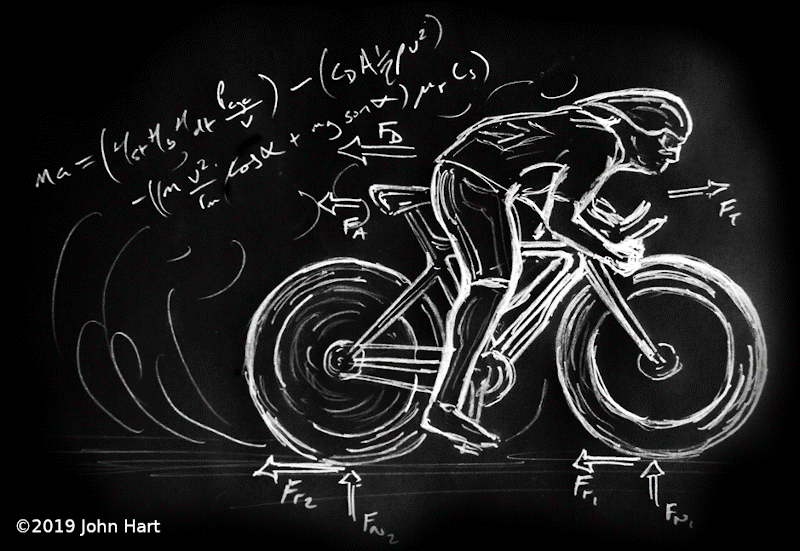The assignments will be done in groups comprised of four or five students. The groups will be formed to mix students from the participating universities and differing disciplines. The groups will be assigned before arrival. You'll have opportunity to get to know each other on the first day. You'll perform your experiment on one or more riders from your group and their chosen human-powered wheeled vehicle.
Groups will need to make use of simple tools and accessible data at your disposal: tape measures, kilometer markers, stopwatches, smartphone sensors, cameras, video cameras, GIS downloads, etc. Be clever and resourceful!
At least one consistent rider should participate in all three assignments so that you can use the data from assignments 1 and 2 to support assignment 3 at the velodrome.
Assignment 1: Estimate Athlete Power Capacity
The objective of this assignment is to estimate aerobic capacity in two ways and anaerobic capacity in one way for at least one member of your group. Both capacity results should be based off of data your group collects, but should be supplemented or supported by values found in relevant scientific literature. You will have the option to do a Wingate and VO2-Max test in the bicycle lab for one subject per team, so the second aerobic test should be using a simple method. [1]
The aims are to:
- Design and execute simple experiments using measurement tools at your disposal to collect the necessary data needed for your estimates.
- Calculate reasonable estimates for the aerobic and anaerobic capacity of the chosen athlete(s).
- Compare the aerobic capacities from the two methods and report on the anaerobic capacity of the single method.
- Report on your experiment and result in the light of available information from sports engineering scientific literature.
| [1] | Your team may opt out of performing the Wingate and VO2max tests. In that case, use simpler tests, another team's data, or data from literature. |
Assignment 2: Estimate Air and Rolling Resistance
The primary objective of this assignment is to estimate the contributions of air resistance and rolling resistance for at least one member of your group and their vehicle. The secondary objective is to compare (drastic) lower or higher air and rolling resistance effects (be creative!). Each estimate should be based off of data your group collects in experimentation and should be supplemented or supported by values found in relevant scientific literature and/or analytical calculations.
The aims are to:
- Design and execute two simple experiments to collect the necessary data needed for calculating air and rolling resistance estimates.
- Calculate reasonable estimates for the two losses for a vehicle and rider of your choice.
- Show the effect of self-chosen vehicle/rider modification that affects the air resistance estimates.
- Show the effect of self-chosen vehicle/rider modification that affects the rolling resistance estimates.
- Report on your experiment and result in the light of available information from sports engineering scientific literature.
In total, you will need data from a minimum of 4 trials: air resistance, rolling resistance, modified air resistance, modified rolling resistance. Select a vehicle and athlete that you will also use for the third assignment at the velodrome. The vehicle cannot be larger than a normal bicycle.
Submit the report to your teams channel "Files" by the deadline and prepare a lightning talk to give during class on the results of your assignment.
Assignment 3: Predict Race Duration
The objective of this assignment is to predict the duration of each of two laps in a race against time and also the distance of a coast down for at least one member of your group and two scenarios of your choice. At least one scenario should be significantly different than simply a time trial of a race bike on the track. For example, think about tire type and pressure, aerodynamic changes, drafting, unusual bicycles (omafiets, e-bike, mountain bike, etc.).
Each scenario should consist of three+ consecutive laps in the safety zone (flat part below the gray part):
- One lap from a standstill to top speed
- One lap at max speed
- Lap(s) from coasting from max speed to standstill
The three predictions you should make are:
- Duration of first lap
- Duration of second lap
- Distance of coast down
Submit your values by 12:00 on Friday to the instructors.
The aims are to:
- Develop a computational model to estimate the race times and coast distance in the velodrome based on collected data and work done in the prior assignments.
- Collect necessary data for the race to make your time prediction using your cycling power balance model.
- Compare the two scenarios and how well you were able to predict both, explaining why.
- Report on your experiment and result in the light of available information from sports engineering scientific literature.
In total you will need data from a minimum of 2 trials, one data set from each scenario.
